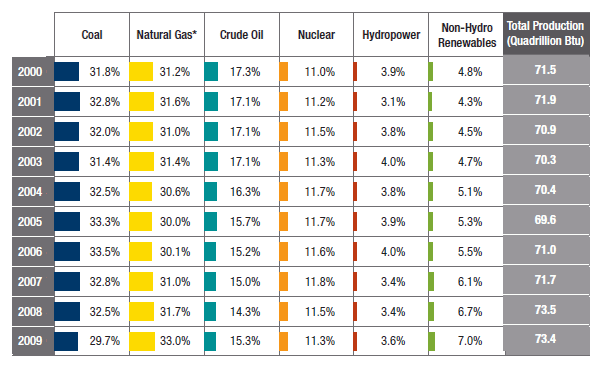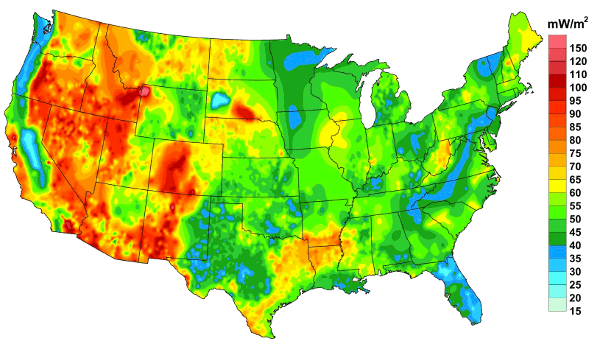Geothermal Energy
November 9, 2011
I reviewed
geothermal energy in a
2007 article (Geothermal Energy, January 26, 2007), so it's time for an update. Renewable energy has become all that more important since 2007; but, as the chart shows, non-
hydroelectric renewables comprise less than 10% of the US energy output, and
geothermal electrical energy in the US, which is about three
gigawatts of installed capacity, is less than a tenth of this.

U.S. Energy Production by Energy Source, 2000–2009, US Department of Energy, 2009 Renewable Energy Data Book, August 2010, page 8.[1]
The US has always been optimistic about the future of geothermal energy. A 2006 report, funded by the
U.S. Department of Energy, concludes that geothermal electrical generation in the US can be increased to ten percent (100 gigawatts) by 2050.[2] Unlike other energy sources, such a large increase in capacity would be feasible, since geothermal energy harvesting is extremely simple. The usual technique is to pump
water into fractured rock deep underground, where it is heated. The resulting
steam or hot water is used to generate electricity at the surface, and the cooled water is cycled back underground to be heated again.
In just one year, 2009, US geothermal capacity increased by six percent when six new geothermal plants which came online to add about 175
megawatts capacity.[4] A 6%
compound annual growth rate will give a ten-fold increase in forty years. The
Geothermal Energy Association estimated that the total online geothermal capacity in the US was 3.15 gigawatts in August, 2009.[4] If the growth rate is constant, this will lead to about 32 gigawatts by 2050, so significant growth will be needed to attain the DOE goal of 100 gigawatts by 2050.
In September of this year, the DOE announced funding by its
Office of Energy Efficiency and Renewable Energy of $38 million over three years in geothermal energy development.[5] This is part of an effort to have the US produce 80% of its electricity from clean energy sources by 2035.[5] The main goal of this program is to reduce the cost of geothermal electricity to make it competitive with other electrical generators.
Fortunately, for the
scientific community, some major funding was given to
universities and
research laboratories. The funded institutions included
Lawrence-Berkeley National Laboratory (Berkeley, California), $540,000;
Stanford University (Stanford, California), $680,000; the
Colorado School of Mines (Golden, Colorado), $1.73 million; the
University of Hawaii (Honolulu, Hawaii), $980,000; the
Idaho National Laboratory (Idaho Falls, Idaho), $1.0 million;
Los Alamos National Laboratory (Los Alamos, New Mexico), $2.6 million;
Sandia National Laboratories (Albuquerque, New Mexico), $740,000; the
University of Nevada (Reno, Nevada), $380,000;
Brookhaven National Laboratory (Upton, New York), $600,000; the
National Energy Technology Laboratory (Albany, Oregon), $770,000; the
National Energy Technology Laboratory (Pittsburgh, Pennsylvania), $1.0 million;
Temple University (Philadelphia, Pennsylvania), $1.5 million; the
University of Texas (Austin, Texas), $1.699 million; and the
University of Utah (Salt Lake City, Utah), $1.99 million.[5]
As present problems with some
hydraulic fracturing projects in the United States illustrate, there are always
unintended consequences involved with almost everything we do.
Disaster caused by underground drilling has captured the popular imagination.
Crack in the World (1965, Andrew Marton, Director) was one of the first films to propose that too much tampering with the Earth's crust to access geothermal energy can have serious consequences.[3] Two episodes of
Doctor Who,
The Hungry Earth (May 22, 2010), and
Inferno (June 20, 1970), have about the same plot.
The most important physical variable in geothermal energy production is the
temperature gradient from the surface of the Earth to its interior. This gradient is a consequence of the temperature of the
Earth's core,
estimated to be about 6000°C. The gradient varies from place to place because of local geology, but it averages about 25°C per kilometer. Other important factors are the
thermal conductivity of the
Earth's crust (about 1.7 W/m/K), and the
specific heat of rock (about 1260 J/kg/K).
In 2004,
David Blackwell and
Maria Richards of
Southern Methodist University produced a detailed geothermal energy map of the US from data obtained peripherally in
oil and gas drilling. This map was one of the resources used in the 2006 US Department of Energy geothermal energy report.[2]
Blackwell and Richards have just updated this map, with funding from
Google, to include twice the number of data sites, bringing the total to 35,000 and improving the
map contours (see figure). One result is that
West Virginia is now identified as an
Appalachian region with higher heat flow and temperature. The West Virginia geothermal energy potential is theoretical equivalent to its existing, mostly
coal-fired, power.[6]

(Image via SMU Geothermal Laboratory. Used with permission.)
Th West Virginia finding is just one important consequence of this study. Most US geothermal energy production has been concentrated in the most visibly geothermal areas in the west, such as the
Geysers Field north of
San Francisco.[6] The study revealed that some places in the east are hotter than some areas in the west, so the
eastern states can profit from geothermal energy, also. Such efforts will be aided by newer drilling methods and technologies that can extract energy from temperature reservoirs as cool as 100°C.[6]
Blackwell released a paper with details of the results of the research at the
2011 meeting of the
Geothermal Resources Council.
References:
- US Department of Energy, 2009 Renewable Energy Data Book, August 2010, page 8.
- "The Future of Geothermal Energy: Impact of Enhanced Geothermal Systems (EGS) on the United States in the 21st Century," 2006 (400 page PDF file).
- Crack in the World, 1965, Andrew Marton, Director, on the Internet Movie Database.
- U.S. Geothermal Energy Capacity Grew 6% in 2009, U.S. Department of Energy - Energy Efficiency and Renewable Energy, Geothermal Technologies Program Press Release, February 10, 2010.
- Department of Energy Awards up to $38 Million to Advance Technology and Reduce Cost of Geothermal Energy, U.S. Department of Energy - Energy Efficiency and Renewable Energy, Geothermal Technologies Program Press Release, September 8, 2011.
- First Google.Org-funded geothermal mapping report confirms vast coast-to-coast clean energy source, Southern Methodist University Press Release, October 25, 2011. This press release also appears as First Google.Org-Funded Geothermal Mapping Report Confirms Vast Coast-to-Coast Clean Energy Source, U.S. Department of Energy - Energy Efficiency and Renewable Energy, Geothermal Technologies Program, October 25, 2011.
- US Department of Energy, Energy Efficiency and Renewable Energy: Geothermal Technologies Program Home Page
Permanent Link to this article
Linked Keywords: Geothermal energy; hydroelectric; geothermal electrical energy in the US; gigawatt; US Department of Energy, 2009 Renewable Energy Data Book, August 2010; U.S. Department of Energy; water; steam; megawatt; compound annual growth rate; Geothermal Energy Association; Office of Energy Efficiency and Renewable Energy; scientific; university; research laboratory; Lawrence-Berkeley National Laboratory (Berkeley, California); Stanford University (Stanford, California); Colorado School of Mines (Golden, Colorado); University of Hawaii (Honolulu, Hawaii); Idaho National Laboratory (Idaho Falls, Idaho); Los Alamos National Laboratory (Los Alamos, New Mexico); Sandia National Laboratories (Albuquerque, New Mexico); University of Nevada (Reno, Nevada); Brookhaven National Laboratory (Upton, New York); National Energy Technology Laboratory (Albany, Oregon); National Energy Technology Laboratory (Pittsburgh, Pennsylvania); Temple University (Philadelphia, Pennsylvania); University of Texas (Austin, Texas); University of Utah (Salt Lake City, Utah); hydraulic fracturing projects in the United States; unintended consequences; disaster; Crack in the World; Doctor Who; The Hungry Earth; Inferno; temperature gradient; Earth's core; thermal conductivity; Earth's crust; heat capacity; specific heat; David Blackwell; Maria Richards; Southern Methodist University; oil and gas drilling; Google; map contour; West Virginia; Appalachian region; coal-fired; SMU Geothermal Laboratory; Geysers Field; San Francisco; Eastern United States; 2011 meeting; Geothermal Resources Council.